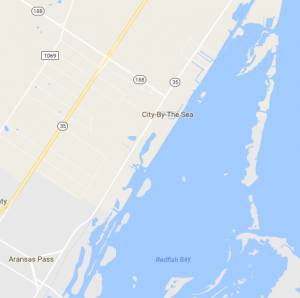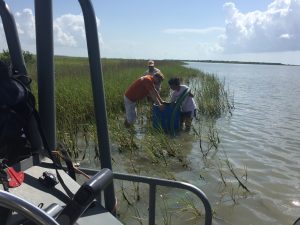Author(s)
Introduction
I was fortunate to assist with four graduate students this summer. Each graduate student had their own research project but all helped each other out. It was a beautiful example of true science. One person cannot progress without another person to either guide, advise, or just lend a hand. Most of my summer was spent on a boat. The project sites were only water accessible and at times two or three projects were being conducted at the same site. I will focus on the research project where the data collected is being compared with the data collected from years past. The research question: are there differences in populations within salt marshes with no mangroves and salt marshes with neighboring mangroves? At 20 sites in Redfish Bay, Goose Island and Mudd Island (half with no mangroves and half with neighboring mangroves), the organisms were collected as well as the salinity. 
In my questioning, I discovered that the study was supposed to end last year but they saw significant changes in the data. The professor decided to extend the study another year and asked another graduate student to continue the research. They are questioning if the changes they are seeing are due to a major rainfall last year. Coincidentally, this year also saw major rainfall. I would like for my students to take a running log of the salinity levels of our bay in their interactive notebooks. I believe this is important for them to understand that rainfall affects more than just how much water is in the lake or how green our lawn is. This data can be graphed, analyzed and predictions can be made. Next year, this data can be used as a comparison. Rainfall affects the organisms in our bays and I want my students to understand how that affects them.
Methods & Procedures
This research project required going to numerous sites. Some were close together while others were quite a boat ride away. A site was chosen because it was roughly within 50 yards of the site chosen the time before. The site is a shallow area on the edge of a salt grass area. The salinity was taken using a refractometer and a 50 gallon bucket with the bottom cut out is placed of over the salt grass edge. The bucket should be firm against the bottom to ensure organisms would not escape and the stalks of the salt grass were counted. Then a tube attached to a pump was placed inside the bucket. For 3 minutes the tube was moved around the inside of the bucket (especially around the inside perimeter) sucking up organisms that were inside. The tube was attached to a net that collected everything that was sucked up. Everything in the net was placed in a 10% ethanol solution to then be identified, measured and counted.
Results
In the field, some areas collected more organisms than others. Different types of small fish, crabs, and small shrimp were just a few of the types of organisms that were visible in the net before being placed in the ethanol solution. It will take the graduate student weeks to months to sort through the samples and identify, count and measure all the organisms that were collected. Then the data will be organized and analyzed before comparing the data from years before. One thing I did notice was that the salinity as a couple of sites was 0 ppt. Ppt stands for parts per thousand which is how the salinity (how much salt is in the water) is measured. Usually the bays are at least in the teens or twenties.
Discussion
I may never know some of the results. For instance, why did some areas have more organisms than others? Did salinity play a factor in this? Maybe there were some bigger predators nearby, or too much wave action from boats going by. I believe it is hard to specify just one variable when so many variables are at play. I do know that salinity does play a major role in what organisms are going to live in that environment. If an organism does not like low salinity, it is going to go elsewhere. This will affect not only its’ prey (what it eats) but it will also affect its’ predators (what eats them). I would like for my students to interact with the tools I used during my summer experience. For example, using a refractometer, trying to collect and measure the organisms. I want my students to really experience being a marine biologist and take ownership in a study of our local environment.
Lesson Plan
5E Lesson: Does Salinity play a factor in catching a fish?
Engage
I will use pictures from the summer research I assisted with, plus pictures of the types of fish, crabs, and shrimp that were collected. I will also have an inquiry into what the students believe is the salinity of our bay. They will be given salinity of the Gulf of Mexico and some surrounding waters so they can have some background knowledge. Have a place on the board for the predictions.
Explore
Lab (to be completed in their interactive notebook)
Materials: (for 4 groups)
4 buckets
Salt water (Instant Ocean which can be ordered online through Amazon or local
aquarium supply store)
Plants (fake is great)
Organisms (Use different candies or plastic fish to represent the organisms)
Refractometer
Turkey baster
Procedure:
Students will have a bucket of salt water with numerous organisms in the water plus salt grass. The salt grass mimics my experience from the research project.
The students will have to take and record the salinity of the water using a refractometer which can be purchased online or at stores carrying supplies for salt water aquariums. Collect or make different water samples so not all lab groups will be the same. To make salt water if natural salt water is not available: Instant Ocean is perfect and can be found at your local pet stores that carry salt water aquariums.
Students will then have 30 seconds to collect as many organisms as they can. Now it would be great to have real organisms but this will probably not happen. I could use small plastic animals or maybe gummy worms and gummy bears, etc. These will represent the different types of organisms.
Now the collection needs to be challenging. So maybe the students could use a turkey baster to suck up the organisms. This will represent the graduate students’ process of sucking up the organisms with a tube and pump.
The students will then count the organisms that are the same and measure each organism. Students will record data into organized tables.
Explain
The students will then analyze their data by creating a graph comparing their type and amount of organisms caught.
Students will also graph the average size of each type of organism.
Students will also compare their salinities with their prediction.
A larger data set can be used by combining all students’ data and graphs. Charts can be constructed and inferences made from the data.
Elaborate
Students will then write a summary/conclusion. The summary should contain the data results plus their analysis of the results. Students should address how they acted like a scientist during the lab.
Evaluation
Students will be put in groups of 3. Each group will create questions they have about the lab.
The students will participate in a Socratic seminar. (www.avid.org has information about Socratic seminars)
The teacher will be able to evaluate the student’s knowledge as well as observe areas that need to be revisited.
Exit ticket
example questions could be:
How could the graduate student improve the process to collect the organisms?
How did the salinity affect the ability of the person to catch the organisms?
What organisms did they expect to find and why?
How did they act like scientists during this lesson?
TEK 6.1(B), 6.2 (A)(B)(C), 6.3(A)(D), 6.4(A)(B)
6(1) Scientific investigation and reasoning. The student, for at least 40% of instructional time, conducts laboratory and field investigations following safety procedures and environmentally appropriate and ethical practices. The student is expected to:
(B) practice appropriate use and conservation of resources, including disposal, reuse, or recycling of materials.
6(2) Scientific investigation and reasoning. The student uses scientific inquiry methods during laboratory and field investigations. The student is expected to:
(A) plan and implement comparative and descriptive investigations by making observations, asking well-defined questions, and using appropriate equipment and technology;
(B) design and implement experimental investigations by making observations, asking well-defined questions, formulating testable hypotheses, and using appropriate equipment and technology;
(C) collect and record data using the International System of Units (SI) and qualitative means such as labeled drawings, writing, and graphic organizers;
€ analyze data to formulate reasonable explanations, communicate valid conclusions supported by the data, and predict trends.
6(3) Scientific investigation and reasoning. The student uses critical thinking, scientific reasoning, and problem solving to make informed decisions and knows the contributions of relevant scientists. The student is expected to:
(A) in all fields of science, analyze, evaluate, and critique scientific explanations by using empirical evidence, logical reasoning, and experimental and observational testing, including examining all sides of scientific evidence of those scientific explanations, so as to encourage critical thinking by the student;
(D) relate the impact of research on scientific thought and society, including the history of science and contributions of scientists as related to the content.
(4) Scientific investigation and reasoning. The student knows how to use a variety of tools and safety equipment to conduct science inquiry. The student is expected to:
(A) use appropriate tools to collect, record, and analyze information, including journals/notebooks, beakers, Petri dishes, meter sticks, graduated cylinders, hot plates, test tubes, triple beam balances, microscopes, thermometers, calculators, computers, timing devices, and other equipment as needed to teach the curriculum; and
(B) use preventative safety equipment, including chemical splash goggles, aprons, and gloves, and be prepared to use emergency safety equipment, including an eye/face wash, a fire blanket, and a fire extinguisher.
